SECONDARY school athletics was a largely contested competition in the ’50s with some good times recorded at the time.
An article published in The Fiji Times on April 27, 1983, quoted the secretary of the Fiji Amateur Athletics Federation, Viliame Saulekaleka, as saying only two sports were prominent then — rugby and athletics.
“We not only produce the country’s best rugby players but also the best school athletes,” Mr Saulekaleka said.
“Facilities were not as good as they are today, but we made do with what we had. An important ingredient that helped athletes at the time was education.”
After the ’50s, there was a lapse in school athletics due mainly to a lack of organisations.
However, through people such as Koroi (president of the Secondary Schools Athletics Association), Bill Oddou (a Peace Corps volunteer), and Mr Saulekaleka, athletics in schools went through a grand revival and developed into what it is now.
Mr Saulekaleka said the revival in the mid-seventies was because of the formation of the physical education department in the Education Ministry.
Trained teachers had to go back to schools and not only coach students but also spur on their interest.
Apart from his tutorship at the Nasinu Teachers Training College, Mr Saulekaleka moved from school-to-school, teaching jumpers how to jump the Fosbury Flop correctly, teaching athletes how to start in races, and the basics of both track and field events.
The article further stated that sponsors such as Island Bottlers Ltd — which had been sponsoring the Jucy Games for eight years — should be highly commended.
Mr Saulekaleka said the sponsorship helped create more awareness of the competition through publicity as well as generous provisions of equipment.
He said one aspect of school athletes that should be looked into was the inclusion of more schools from the outer islands.
“Plenty of untapped material there.”
Coaching and proper facilities were needed in these areas, but the Jucy Games — now known as the Coca-Cola Games — were said to be recording a good performance from all the schools, especially with the modern running tracks at the national stadium.
He said judging from the performance in individual schools and inter-zone competitions, the girls should come up with good records, but the boys’ potential would undoubtedly shine.
Future champions could emerge and they should be given close specialist attention, he added.
The Latter-day Saints 4×100 relay team (from left) Jone Maka, Seremaia Tui, Vereniki Vosailagi and Maciu Vili train at the National Stadium in preparation for the Jucy Games.
Picture: FT FILE



